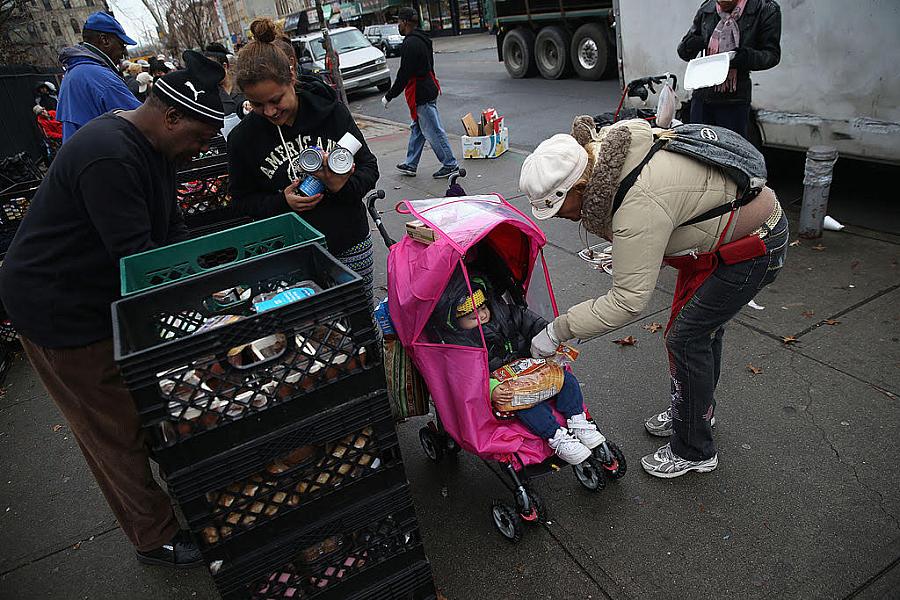As Washington wrestles over health reform, communities brace for impacts on children

Previous cuts to the food stamp program in 2013 led to a spike in need among low-income families. The Bowery Mission program in Brooklyn distributes food to families. (John Moore/Getty Images)
Uncertainty about proposed budget and policy changes in Washington have put low-income and working families — and the programs and agencies that serve them — on high alert. Health, nutrition, child care, education, housing and welfare programs have been targeted for significant reductions. Combined, advocates fear these potential cuts threaten children's most basic needs. Communities are seeking innovative — and quick — solutions to deal with what they see as an impending crisis for poor and working families.
Health care
In Washington’s new world order, who’s going to pay the bills for sick kids to see a doctor? It’s a big concern, especially for low-income families. And with all the back-and-forth in D.C. today, it remains a big unknown.
Right now, for every 10 children in the United States, nearly four are covered by the nation’s largest health insurer, Medicaid. Together with CHIP (the state-run Children’s Health Insurance Program), the government guarantees health care for 35 million children, according to the Centers for Medicare and Medicaid Services latest enrollment report in April. In other words, half of the low-income patients for whom the government pays medical bills are under 18 years old. Dramatic cuts in these programs would have a disproportionate effect on the nation’s youngest patients.
In Washington, health reform is up in the air. President Trump has proposed a budget that cuts more than $600 billion from Medicaid over 10 years. It’s not clear how much that overlaps with the $839 billion in cuts called for in the House of Representatives’ reform bill. The Senate recently released its own reform bill that includes even deeper cuts over time, restructuring the program and slowly rolling back the Affordable Care Act’s Medicaid expansion, more commonly known as Obamacare. In all, 32 states plus the District of Columbia expanded Medicaid under Obamacare. Those states — and primarily children living in those states — face the biggest impact if Medicaid funding is reduced.
The Congressional Budget Office estimates that 23 million people would lose insurance over the next decade under the House plan. The CBO subsequently announced a nearly equal 22 million would become uninsured under the Senate proposal. The Robert Wood Johnson Foundation says “the impact extends well beyond the health and welfare of their own constituents. This bill would negatively affect the most vulnerable Americans regardless of where they live.”
But what’s the alternative? Republicans argue Obamacare is “imploding.” A New York Times analysis this month found that next year 35,000 Americans will have no choices and another 3 million will have only one choice in their ACA marketplaces. The lack of insurers amounts to a similar effect for the next tier of patients — working class families seeking “affordable” insurance.
Nutrition and other programs
The Trump budget also proposes $274 billion in welfare reform. Most of that reduction comes from cuts to the Supplemental Nutrition Assistance Program (SNAP), more commonly known as food stamps. That amounts to a 25 percent reduction in benefits to 42 million people. Additional cuts in before-and-after school programs could affect snacks that sustain children between lunch and dinner.
Temporary Assistance for Needy Families (TANF), which assists with food, housing and child care, is also slated for a $21 billion reduction in funding over the next decade.
The families affected
Those are the numbers — but what’s the real impact “on the ground?” For our 2017 National Fellowship project, our NBC News Channel team proposes to take an in-depth look at some of the hardest hit areas, like California. Its Medicaid expansion was larger by far than any other state. Agencies like the Children's Collective in South Los Angeles are ground zero for children whose families could be affected by one or more of the proposed changes.
This nonprofit serves more than 1,200 children a year, relying on funds from a number of different federal programs to feed, educate and ensure access to health care to children in one of the county’s most vulnerable areas. They provide 225,000 meals a year, partner with a local health clinic for general health care services, and provide specific programs for obesity prevention and early childhood trauma. Many of their key programs are backed by or tied to federal funding from USDA, HUD and other agencies. Washington’s indecision has the agency on edge. Director Jackie Kimbrough tells me she’s greatly concerned about the impact of cuts on families already in fear of losing their Medicaid benefits.
We also hope to visit places like Knoxville, Tennessee, where the last major insurer, Humana, has announced it’s leaving the market next year. Humana’s exit threatened to leave approximately 40,000 people in the area without health insurance, while Blue Cross Blue Shield of Tennessee has since said it will re-enter the market there.
But in the dozens of counties with no insurers, what will working class families do, given their lack of options for subsidized health care? What choices will families make when their children get sick — cut other essentials to pay for more expensive insurance, or head to the emergency room? How will local clinics and hospitals handle an onslaught of more uninsured children? What community solutions are in the works to address the issues expected to surface no matter what Washington decides to do with health reform?
Our aim is to produce a series of reports that examine the shifting politics of health care and nutrition in Washington, juxtaposed with the very real impact already being felt in communities throughout the country.

